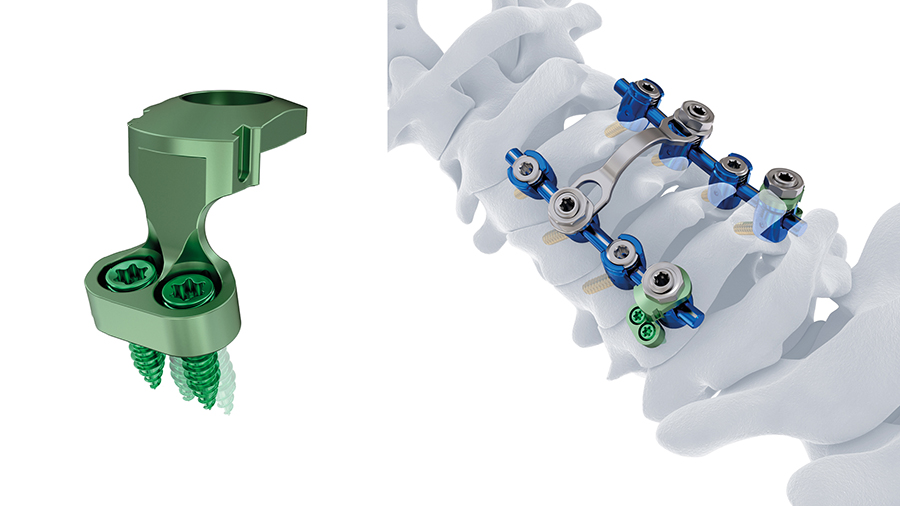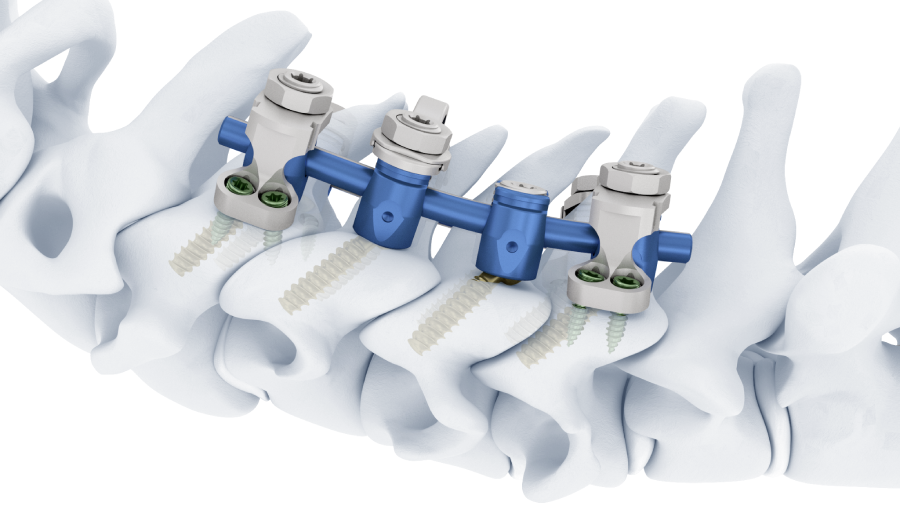
SYMPHONY OCT System—Compartment 2
The SYMPHONY OCT System is an enhanced set of instruments and implants for posterior fixation of the occipital-cervical junction, subaxial spine, and cervico-thoracic junction. Compartment 1 of the SYMPHONY OCT system was launched in November 2019, and was described in the 2019 issue of the Innovations magazine (Innovations Magazine 2019)
SYMPHONY Compartment 1 has recently been supplemented by enhanced and innovative elements (Compartment 2) to further address surgical needs and avoid pitfalls in complex cervical surgery. Launched in early 2021, the Compartment 2 components include MULTIPOINT SECURE (Fig 1) to augment lateral mass screws, reduction screws, advanced connector and various rod designs, a short drill guide and polydriver. This additional feature builds on the advanced features already found in Compartment 1 taking the best of Synthes Synapse and DePuy Mountaineer.
By optimizing and improving instruments and implants for posterior cervical fusion (PCF) following FATE principle (fixation, alignment, targeting, and extension), Compartment 2 also addresses surgical and technical concerns in an aging population with suboptimal bone quality and in patients who may require stronger constructs meeting the indications for spinal fusion.
Fig 1 MULTIPOINT SECURE adaptor with a two-screw fixation.
Disclaimer:
Hazards and labeling
Due to varying countries’ legal and regulatory approval requirements, consult the appropriate local product labeling for approved intended use of the products described on this website. All devices on this website are approved by the AO Technical Commission. For logistical reasons, these devices may not be available in all countries worldwide at the date of publication.
Legal restrictions
This work was produced by AO Foundation, Switzerland. All rights reserved by AO Foundation. This publication, including all parts thereof, is legally protected by copyright.
Any use, exploitation or commercialization outside the narrow limits set forth by copyright legislation and the restrictions on use laid out below, without the publisher‘s consent, is illegal and liable to prosecution. This applies in particular to photostat reproduction, copying, scanning or duplication of any kind, translation, preparation of microfilms, electronic data processing, and storage such as making this publication available on Intranet or Internet.
Some of the products, names, instruments, treatments, logos, designs, etc referred to in this publication are also protected by patents, trademarks or by other intellectual property protection laws (eg, “AO” and the AO logo are subject to trademark applications/registrations) even though specific reference to this fact is not always made in the text. Therefore, the appearance of a name, instrument, etc without designation as proprietary is not to be construed as a representation by the publisher that it is in the public domain.
Restrictions on use: The rightful owner of an authorized copy of this work may use it for educational and research purposes only. Single images or illustrations may be copied for research or educational purposes only. The images or illustrations may not be altered in any way and need to carry the following statement of origin “Copyright by AO Foundation, Switzerland”.
Check www.aofoundation.org/disclaimer for more information.
If you have any comments or questions on the articles or the new devices, please do not hesitate to contact us.
The brands and labels "approved by AO Technical Commission" and "approved by AO Foundation", particularly "AO" and the AO logo, are AO Foundation's intellectual property and subject to trademark applications and registrations, respectively. The use of these brands and labels is regulated by licensing agreements between AO Foundation and the producers of innovation products obliged to use such labels to declare the products as AO Technical Commission or AO Foundation approved solutions. Any unauthorized or inadequate use of these trademarks may be subject to legal action.








